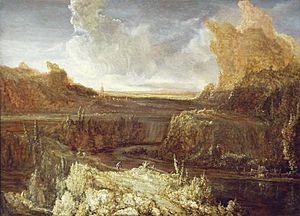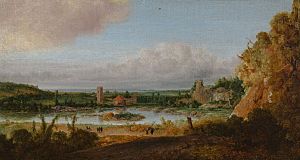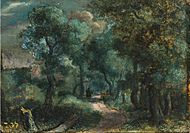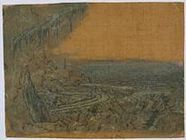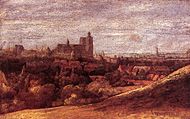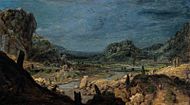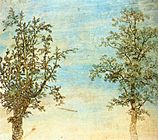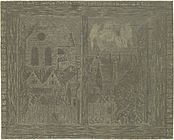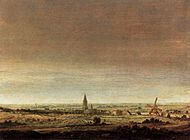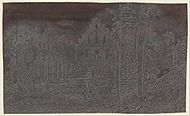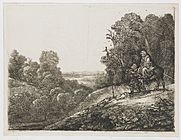Hercules Seghers facts for kids
Quick facts for kids
Hercules Seghers
|
|
|---|---|
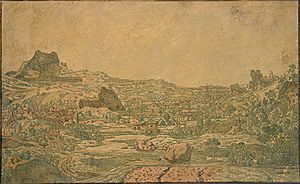
Hercules Segers, Town with four towers, c. 1631; etching & drypoint. Cincinnati Art Museum. A typically unusual etching: printed in green on coloured cotton, and worked over with grey and black washes.
|
|
| Born |
Hercules Pieterszoon Seghers
c. 1589 |
| Died | c. 1638 |
| Nationality | Dutch |
| Known for | Painting, Printmaking, Landscape art |
| Movement | Dutch Golden Age |
Hercules Pieterszoon Seghers (around 1589 – around 1638) was a Dutch artist from the Dutch Golden Age. He was a talented painter and printmaker. People often call him one of the most creative and experimental landscape artists of his time. He was especially good at making unique prints.
Contents
The Life of Hercules Seghers
Hercules Seghers was born in Haarlem, a city in the Netherlands. His father was a cloth merchant who moved their family to Amsterdam in 1596. In Amsterdam, young Hercules began learning art from a famous landscape painter named Gillis van Coninxloo. Sadly, his teacher passed away in 1606, cutting his training short.
After his father died in 1612, Hercules went back to Haarlem. He joined the local artists' group, the Haarlem Guild of St. Luke. In 1614, he returned to Amsterdam. The next year, he married Anneke van der Brugghen.
In 1620, Hercules bought a large house in Amsterdam. From his art studio at the top of the house, he could see the Noorderkerk, a church that appears in one of his etchings. By the late 1620s, he faced financial difficulties and had to sell his house in 1631.
He then moved to Utrecht and started selling art. In 1633, he moved again to The Hague. It is believed he passed away around 1638. Later stories suggest he had a difficult end to his life. After he died, his reputation grew thanks to a book that described him as a brilliant but misunderstood artist.
Seghers' Amazing Prints

Hercules Seghers is most famous for his very creative etchings. These were mostly pictures of landscapes. He often printed them on different colored paper or even cloth. He also used colored inks and would hand-color his prints. Sometimes, he would even cut them into unusual shapes!
He used special techniques like drypoint and a type of aquatint to create unique textures. He even ran rough cloth through his printing press to make a bumpy effect on his prints.
Today, only about 183 of his prints are known to exist, and most are kept in museums. The Rijksmuseum in Amsterdam has the best collection. Even the famous artist Rembrandt admired Seghers' work. Rembrandt owned eight of Seghers' paintings and even one of his original printing plates. Rembrandt reworked this plate to create his own print, keeping much of Seghers' original landscape.
One of Seghers' prints, Town with four towers, is thought to be from around 1631. Because so few of his prints survived, it's unlikely he made a lot of money from them. He also made a very unusual print of a Pile of books, which was rare for artists in the 1600s.
Seghers is also believed to have invented a special etching technique called "sugar-bite" aquatint. This technique was later rediscovered by another artist over a hundred years later!
Seghers' Beautiful Paintings
While his prints are very special, Hercules Seghers was probably known more for his paintings during his lifetime. He painted landscapes and still-life pictures, like The River Valley. His paintings are also very rare today, with only about fifteen known to still exist. One of his paintings was sadly destroyed in a fire in 2007.
In 1632, a very important person, the Stadholder, Frederick Henry, Prince of Orange, bought some of Seghers' landscapes. Many of his painted landscapes show amazing, imaginary mountains. His paintings often show wide, horizontal views, focusing more on the land than the sky. Some of his paintings even had extra strips of sky added later by other artists to fit new art trends.
Seghers was inspired by other Flemish landscape painters like Joos de Momper and Roelandt Savery. He also used the imaginative and dream-like style of Mannerism in his landscapes. An old record from 1680 mentions that a marine painter named Jan van de Cappelle owned five of Seghers' paintings. One of them was described as a view of Brussels. If this is true, it means Seghers might have traveled there when he was younger.
Gallery
-
Seghers, View of Brussels from the North-East, c. 1625; oil on panel
-
Seghers & (thereafter) Rembrandt, Rest on the Flight into Egypt, c. 1653; etching, drypoint and burin
See also
 In Spanish: Hercules Pieterszoon Seghers para niños
In Spanish: Hercules Pieterszoon Seghers para niños


